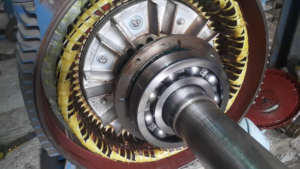In the heart of every industrial operation lies a critical component often overlooked until it fails – the motor. Motors silently drive manufacturing processes, pumps, and machinery.
Yet, when motors fail, the consequences are severe, causing unexpected downtime, costly repairs, and a ripple effect that disrupts the entire production line.
Failure of a motor can send a shockwave through a manufacturing facility. When you understand common failures and how to prevent them, it can help ease the mind.
At HESCO, we see firsthand how devastating motor failures can be for our customers. We understand the challenges they face and the critical importance of keeping motors running smoothly. By understanding the common causes of motor failures and learning how to prevent them, you can safeguard your operations and gain peace of mind.
Let’s dive into common motor failures, the warning signs to watch for, and the best strategies for prevention and resolution.
Common Causes of Motor Failures and Warning Signs
In motors, two common issues occur, triggering the motor to fail: bearing issues and bad windings.
Though these are not the only two issues, they are most commonly seen. But, what do these exactly mean and how do you know these are the reasons for the motor failing?
Problem #1: Bearing Issues
Before we get into what a bearing issue entails, let’s walk through what a bearing is.
Bearings are a rotating shaft and the part that supports rotation. With their rotation, they reduce friction and allow for a smoother rotation.

Source: IBT Inc
When a bearing fails, the motor will automatically fail. It cannot run with a faulty bearing. It is easy to see when a bearing has failed. The first tell-tail sign is an excessive vibration, causing the motor to move around and rattle. After this, the bearing will begin to heat up past its acceptable level, producing additional noises that could lead to grinding.
Problem #2: Bad Windings
Another common failure beyond the bearings is a bad winding.
A winding is an arrangement of electrical conductors that generate magnetic fields in a motor. This drives the rotor to spin.
In simpler terms, a winding creates a path for a current to flow through, which spins the rotor.

Source: Baumueller
When a winding is operating properly, its AC and DC measurements are balanced. When those measurements are unbalanced, a fault is indicated, and the motor will fail. To help you identify a bad winding, check these three key aspects:
- Deterioration: a sign would be a broken part, burn, or contamination (rust or moisture)
- Test WInding Resistance: using an ohmmeter or multimeter, check its resistance. If outside of the manufacturer’s recommended range, there is likely a problem.
- Test for Shorts or Opens: Use a multimeter set to ohms and test the motor’s wires and terminals. A reading of 0 can indicate a short and a reading of 2 to infinite indicates open.
Warning Signs of Motor Failure
When a motor fails, there are likely signs to look for – it is not often that a motor stops working without signs being evident prior.
Detecting these failures early can save significant time, money, and resources. By recognizing signs, maintenance teams can address issues before they lead to catastrophic failures. Here are a few key indicators to watch for:
- Vibration: While some vibration is normal in operating motors, an increase in intensity or frequency can indicate developing issues.
- Unusual Noises: Motors should operate with a consistent, low-level hum. Any grinding, squealing, or rattling sounds are cause for concern and should be investigated immediately.
- Overheating: Motors generate heat during operation, but excessive heat can indicate overloading, poor ventilation, or winding issues. Regular temperature monitoring can help identify this problem early.
- High Current Draw: Abnormal current readings, especially if one phase draws more current than the others, can signal potential winding problems.
Modern Technologies for Predicting and Preventing Motor Failures
Cutting-edge technologies are enhancing how we monitor and maintain industrial motors. Two key innovations stand out in predicting and preventing motor failures: vibration analysis and accurate current measurement systems.
A vibration analysis are advanced sensors that can detect minute changes in a motor’s vibration pattern, often impossible to sense by a human. By analyzing these patterns, you can identify early signs of bearing damage, rotor imbalances, or misalignments long before they escalate into major issues. These analyses also can detect eddy currents, which is a subtle current that gradually wears on bearings. This early warning system allows for planned maintenance interventions, dramatically reducing unexpected downtime and extending motor life.
Equally crucial is the role of accurate current measurements in predicting motor health. Modern current monitoring systems go beyond simple amp readings, providing detailed insights. By detecting even slight imbalances in the current draw, these systems can alert technicians to developing winding issues. Early detection of such problems is critical, as winding failures, if left unchecked, can lead to catastrophic motor burnout. With real-time monitoring and smart algorithms, these systems can predict potential failures weeks or even months in advance, allowing for timely repairs or replacements.
By integrating these technologies into a comprehensive motor management strategy, industrial facilities can shift from reactive maintenance to a proactive, predictive approach. This saves on repair costs and optimizes motor performance with uninterrupted production. Every minute of downtime translates to significant losses and these smart technologies are essential for staying competitive in the modern industrial landscape.
Powering the Future: Embracing Proactive Motor Management
Motor failures in industrial automation systems can have far-reaching consequences. From unexpected downtime to costly repairs, these issues significantly impact productivity and profitability. However, with knowledge about common failure causes, warning signs, and cutting-edge preventive technologies, industries can try to prepare and get ahead of the curve for motor failures.
Proactive maintenance is no longer a luxury—it’s a necessity. By implementing regular inspections, leveraging advanced vibration analysis, and utilizing precise current measurement systems, you can catch potential issues before they escalate into major problems.
At HESCO, our expert technicians can shine a light on your motor issues before they occur. Don’t get caught in the dark – let us help you get ahead of motor failures. Contact us today to keep your motors running strong.
